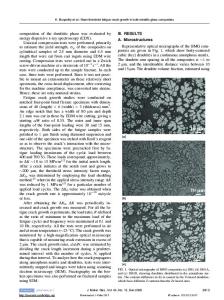Fatigue of Fiber-reinforced Composites
Fatigue has long been recognized as a mechanism that can provoke catastrophic material failure in structural applications and researchers are now turning to the development of prediction tools in order to reduce the cost of determining design criteria for
- PDF / 8,997,742 Bytes
- 246 Pages / 439.37 x 666.142 pts Page_size
- 85 Downloads / 463 Views
For further volumes: http://www.springer.com/series/4604
Anastasios P. Vassilopoulos Thomas Keller
•
Fatigue of Fiber-reinforced Composites
123
Dr. Anastasios P. Vassilopoulos Composite Construction Laboratory (CCLab) École Polytechnique Fédérale de Lausanne (EPFL) School of Architecture, Civil and Environmental Engineering (ENAC) Station 16 1015 Lausanne Switzerland e-mail: [email protected]
ISSN 1619-0181 ISBN 978-1-84996-180-6 DOI 10.1007/978-1-84996-181-3
Prof. Thomas Keller Composite Construction Laboratory (CCLab) École Polytechnique Fédérale de Lausanne (EPFL) School of Architecture, Civil and Environmental Engineering (ENAC) Station 16 1015 Lausanne Switzerland e-mail: [email protected]
e-ISBN 978-1-84996-181-3
Springer London Dordrecht Heidelberg New York British Library Cataloguing in Publication Data A catalogue record for this book is available from the British Library Ó Springer-Verlag London Limited 2011 Celeron, Celeron Inside, Centrino, Centrino Inside, Core Inside, Intel, the Intel logo, Intel Atom, Intel Atom Inside, Intel Core, Intel Inside, the Intel Inside logo, Intel vPro, Itanium, Itanium Inside, Pentium, Pentium Inside, vPro Inside, Xeon, and Xeon Inside are trademarks of Intel Corporation in the U.S. and/ or other countries. Apart from any fair dealing for the purposes of research or private study, or criticism or review, as permitted under the Copyright, Designs and Patents Act 1988, this publication may only be reproduced, stored or transmitted, in any form or by any means, with the prior permission in writing of the publishers, or in the case of reprographic reproduction in accordance with the terms of licenses issued by the Copyright Licensing Agency. Enquiries concerning reproduction outside those terms should be sent to the publishers. The use of registered names, trademarks, etc., in this publication does not imply, even in the absence of a specific statement, that such names are exempt from the relevant laws and regulations and therefore free for general use. The publisher makes no representation, express or implied, with regard to the accuracy of the information contained in this book and cannot accept any legal responsibility or liability for any errors or omissions that may be made. Cover design: eStudio Calamar, Berlin/Figueres Printed on acid-free paper Springer is part of Springer Science+Business Media (www.springer.com)
Preface
Examples of composite materials abound in nature—wood, flower stems and bones are typical natural composite structural elements that have ‘‘adopted’’ the composite concept in order to develop and serve specific needs. Human history is also full of paradigms of the use of composite systems for particular applications— straw mixed with mud to fabricate bricks (Bible, Exodus 5.15-18) and laminated composite shields together with the description of weapon behavior in battle were presented in detail in the Homeric epics (Iliad 18.474-482). It was not until the 20th century, however, that fiber-reinforced polymer composite ma
Data Loading...











